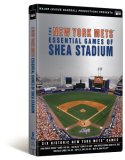| Reviews & Columns |
|
Reviews DVD TV on DVD Blu-ray 4K UHD International DVDs In Theaters Reviews by Studio Video Games Features Collector Series DVDs Easter Egg Database Interviews DVD Talk Radio Feature Articles Columns Anime Talk DVD Savant Horror DVDs The M.O.D. Squad Art House HD Talk Silent DVD
|
DVD Talk Forum |
|
|
| Resources |
|
DVD Price Search Customer Service #'s RCE Info Links |
|
Columns
|
|
|
New York Mets Essential Games Of Shea Stadium, The
Memorable games from a forgettable stadium
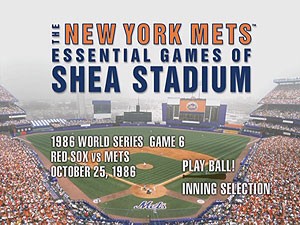 Reviewer's Bias*
Reviewer's Bias*
Loves: Yankees
Likes: Baseball
Dislikes: Mets
Hates: Red Sox, Red Sox fans
The Show
This year, New York is saying goodbye to a stadium that's been home to many big moments, including championships and cultural events. Its replacement nearly ready, nostalgic memories of home runs and pitching gems flood back, as the end of an era inches ever closer.
Then there's Shea Stadium.
Never beloved, never awe-inspiring, this utilitarian ballpark, positioned in the path of an airport's jets, is generally considered a bit of a dump, without anything particularly impressive about. The only thing anyone wants to see carried over to their new stadium is the run-down Big Apple in a Hat that's fired up when the Mets hit a home run. That the only piece to be considered for transplantation is a tacky gizmo that would fit in at a sub-par garage sale, says it all about Shea Stadium.
The six games chosen for this set have a range of reasons for being selected, though oddly, none of them were series-clinchers. In most cases, it's a big late-game hit that finished the game, in one, it's an excellent pitching performance, and one is one of the most legendary screw-ups in the history of pro sports. It's unusual to not include the two games that resulted in World Series celebrations at Shea, though admittedly, both were proceeded by more interesting events. The only one that really seems out of place is a regular season game with nothing much on the line, seemingly included because of who the opponent was.
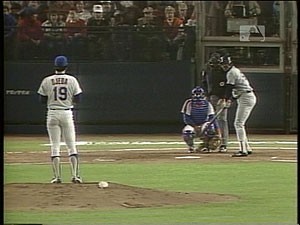 The first contest is Game 4 of the 1969 World Series, against the Baltimore Orioles, a low-scoring affair that starred then-young ace Tom Seaver, who held the O's hitless for eight innings, before surrendering a run to send the game to extra innings. After Baltimore manager Earl Weaver is tossed early, the game ends with some controversy over interference. Unfortunately, without much scoring, outside those bits of drama, it's a bit of a slow game, with only the last two innings serving up much excitement.
The first contest is Game 4 of the 1969 World Series, against the Baltimore Orioles, a low-scoring affair that starred then-young ace Tom Seaver, who held the O's hitless for eight innings, before surrendering a run to send the game to extra innings. After Baltimore manager Earl Weaver is tossed early, the game ends with some controversy over interference. Unfortunately, without much scoring, outside those bits of drama, it's a bit of a slow game, with only the last two innings serving up much excitement.
Things were lean in Queens until 1986, when the Mets returned to greatness (and madness off the field), a year represented by two games in this set. First up is Game 3 of the 1986 NLCS against the Houston Astros. The Mets never led in the game, which followed a 1-1 start in the series, and were down by one run in the bottom of the ninth. The victory came from unheralded blue-collar slugger Lenny Dykstra though, who stroked the winning walk-off home run, making him a cult hero in New York. The game again had some controversy on the base paths, and was an example of an offense-first, defense-when-you-feel-like-it postseason.
That couldn't be more obvious than in Game 6 of that year's World Series, where the Mets hosted the Red Sox, on the brink of elimination at Boston's hands. The game, with five errors between the two teams, was a nightmare that haunted New England for decades, as the ball that rolled through Bill Buckner's legs let victory drift away from Boston. Watching the game on DVD, you get to appreciate the fact that Buckner didn't deserve the blame he received, when you watch the events that led up to that moment.
With no championships since then, the final three games aren't quite as meaningful to the franchise, starting with Game 5 of the 1999 NLCS series with the Atlanta Braves. Down 3-1 in the series, after a war of words prior to the the late-season comeback that got the Mets into the playoffs, the Mets pulled it together to hang tough with the rival Braves, in a low-scoring game that went a lengthy rain-filled 15-innings. The Braves actually pulled ahead in the top of the 15th, before Robin Ventura smacked a grand slam, leading to a movie-worthy mobbing by his teammates, nearly six hours after the game started. Unfortunately, the good feelings were short-lived, as New York lost a shootout in Game 6.
The next entry is less about the game on the field, as the Mets again took the field against the Braves, this time on September 21, 2001, the first baseball game in New York following the terrorist attack of 9/11. An emotional game, preceded by musical performances by Diana Ross and Marc Anthony, it was tight until the eight inning, when Mike Piazza hit a two-run homer that lifted the fans in the stadium. With then-Mayor Rudy Giuliani and a number of first-responders in attendance, and the players wearing caps representing those who helped the city, it still has an impact, and having the game called by the Fox Sports New York team, including play-by-play pro Howie Rose, gave it the right sense of community, which would have been missing from a national game broadcast.
The final inclusion is a questionable one, a May 2006 match-up between the Mets and Yankees. Considering how early in the season this game took place, it had little impact on the teams or the standings, as the two squads traded blows early, before settling down to a less-frantic pace and a 6-6 tie. Eventually, Mets marquee idol David Wright came through in the bottom of the ninth, with an RBI single that downed their cross-town foes. Outside of the walk-off victory, one of many for the Mets in '06, it's just not that important a game. Why they didn't include the Mets' Game 3 victory over the Yankees at Shea in the 2000 World Series, a much bigger game on a much bigger stage, make this an even bigger question mark in this set.
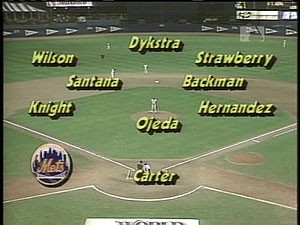 While checking out these games, at least to me, the actually play was far less interesting than how the game was broadcast, or what was going on in the stadium. The changes in broadcast style and technique, including the use of on-screen graphics, the choice of angles, the frequency of replays and advertising, and especially the announcers. Things get progressively more complicated visually, yet increasingly simplistic as far as announcing goes, as they stray further and further from what's happening on the field. After suffering through recent trends in commentary, it's amazing to see an important athletic accomplishment not get overrun by a bombastic announcer, who can't shut up and let the moment speak for itself. It's also bizarre to see the stands filled with men in suits and ties, when today you can barely get ticketholders to keep their tight authentic jerseys on.
While checking out these games, at least to me, the actually play was far less interesting than how the game was broadcast, or what was going on in the stadium. The changes in broadcast style and technique, including the use of on-screen graphics, the choice of angles, the frequency of replays and advertising, and especially the announcers. Things get progressively more complicated visually, yet increasingly simplistic as far as announcing goes, as they stray further and further from what's happening on the field. After suffering through recent trends in commentary, it's amazing to see an important athletic accomplishment not get overrun by a bombastic announcer, who can't shut up and let the moment speak for itself. It's also bizarre to see the stands filled with men in suits and ties, when today you can barely get ticketholders to keep their tight authentic jerseys on.
The DVD
The place this set really shines is in the packaging, making it the complete opposite of Shea Stadium. The six-disc set (one disc per game) arrives in a slick steelbook case that holds the overlapped platters, two inside each cover, and two more on an additional tray. If all multi-disc sets could be packaged this way, America's overburdened DVD shelved would breathe a sigh of relief.
The discs themselves are pretty sweet as well, as the art shows the date of the game, the team logos, a one-line synopsis and the inning-by-inning box score. Once you get the disc into your machine, there's a simple static full-frame menu with two choices: play the game or select an inning. The inning selection menu is well-done, as you move the cursor around the box score of the game, and choose either the top or bottom of the innings. There are no audio options, no subtitles and no closed captioning.
The Quality
The quality of the full-frame video on these discs varies with the age of the games, but it's not as different as you might expect from a set that spans almost 40 years of Mets history. The older games feature less vibrant color, but are still pretty crisp, while the '80s match-ups actually look a bit worse, with that harsh, dark digitized video that marks broadcasts from the era. There's a disclaimer at the start of each DVD noting that there are some imperfections in the video that are in the master tapes, and there are some noticeable ones that crop up, more so in the older games.
The games are presented with Dolby Digital 2.0 tracks that deliver the play-by-play, commentary and in-game audio clearly, with the more recent entries sounding a bit more bold. It's pretty hysterical to hear everything get drowned out by the jets flying over Shea during the 1969 game.
The Extras
The bonus material is held on the sixth DVD, where there's 11 pieces of assorted Shea Stadium footage, totalling about 67 minutes in all. Among the clips are the final inning of the '69 World Series, highlights from Game 7 of the '86 World Series, as well as series-clinching wins, game-winning moments and a short interview with the stadium's namesake. The final inning of the '69 series is amazing to watch, as the fans lose their minds and swarm the field, while '86 is crazy as well, with a smoke bomb thrown on the field. These bits are more along the lines of what fans might be looking for, as they are exciting individual moments, without all the slow lead-up.
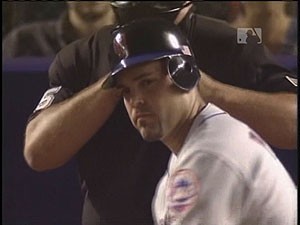 The Bottom Line
The Bottom Line
Despite its dismal reputation, Shea Stadium has been the site of some big games in its time, thanks to a couple of World Series championship teams, as well as some near-misses. Ironically though, The most well-known game Shea ever is famous for the bad plays that occurred, instead of good baseball. The DVDs are somewhat similar to the stadium they celebrate, getting the job done, but keeping the presentation simple and the bells and whistles to a minimum. Mets fans may like to remember the good times at Shea, not all of which are included here, but most others will be content with just saying goodbye.
Francis Rizzo III is a native Long Islander, where he works in academia. In his spare time, he enjoys watching hockey, writing and spending time with his wife, daughter and puppy.Follow him on Twitter
*The Reviewer's Bias section is an attempt to help readers use the review to its best effect. By knowing where the reviewer's biases lie on the film's subject matter, one can read the review with the right mindset.
|
| Popular Reviews |
| Sponsored Links |
|
|
| Sponsored Links |
|
|
| Release List | Reviews | Shop | Newsletter | Forum | DVD Giveaways | Blu-Ray | Advertise |
|
Copyright 2024 DVDTalk.com All Rights Reserved. Legal Info, Privacy Policy, Terms of Use,
Manage Preferences,
Your Privacy Choices | |||||||









